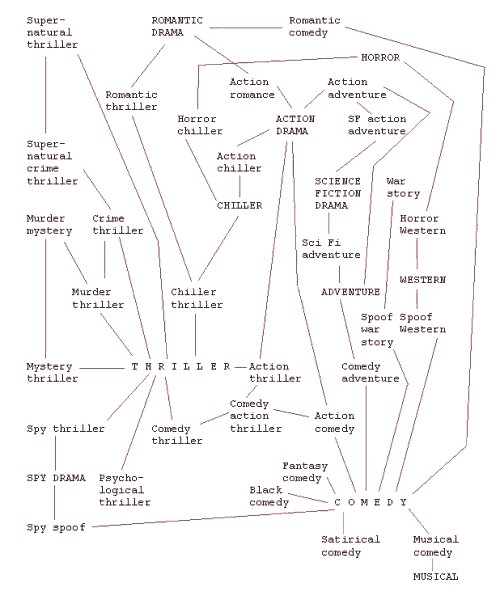Lesson 2: Genre
Layers of Semiotic Analysis (2)
|
Class assignment (group work, done orally):
1. Try to find all the elements from the previous scheme in this description.
2. Use the "film-genres" scheme to define the genre.
Casual Danger Dialog
In Real Life, when someone is being chased, about to be captured, about to fall off a cliff, or anything that could result in death or something nearly as bad, they get scared.
It shows in their tone of voice and the things they say.
"Help!" they scream, or "I'm over here!" They may even whimper to themselves,
"I don't want to die, please don't let me die," or something similar.
But this doesn't carry over to TV, movie, cartoon, or book characters. Whenever a character in a work of fiction is in danger, unless the fiction is meant to be realistic drama, that character tends to do one of several things:
- Crack a joke about the danger.
(e.g. bad guys walk in, and one of the heroes says "I don't think that's the welcoming committee!" or something similarly stupid)
- Crack a joke to get people's attention. (e.g. someone hanging from a cliff says "hey guys? Over here!")
- Argue or speak casually while the danger is going on. Bonus points if the argument briefly stops for one of the heroes to shout "look out!" and then resumes shortly afterward.
- Act as if the danger is real in their dialog, but speaking more
calmly than one would likely do in real life. (e.g. "This Is Gonna Suck").
The last one is most common in shows that don't lean too far towards humor, or want to be realistic without being too realistic to the point of drama. The first three are used mostly for comedic effect, and appear a lot in cartoons, especially action cartoons.
Either way, Casual Danger Dialog is usually used to make the mood more fun,
rather than realistic. Seeing Shaggy and Scooby Doo run around screaming for help
in pained tones of voice, with tears running down their face as they fear for their life,
is not entertaining. Especially if it happens "Once An Episode". Hence the need to tone down the level of fear. In more realistic stories, dialog showing realistic fear is sometimes reserved for when the heroes are reflecting on the danger.

|
Resources for Lesson 1:
Chandler, Daniel. Semiotics for Beginners.
http://www.archive.org/search.php?query=creator%3A%22Dr.%20B.%20Keith%20Murphy%2C%20Ph.D.%22
Noth, Winfried (1990): Handbook of Semiotics. Bloomington, IN: Indiana University Press
Innis, Robert E (Ed.) (1986): Semiotics: An Introductory Reader. London: Hutchinson
Genosko, Gary (1994): Baudrillard and Signs: Signification Ablaze. London: Routledge
|
Пермский государственный университет
|